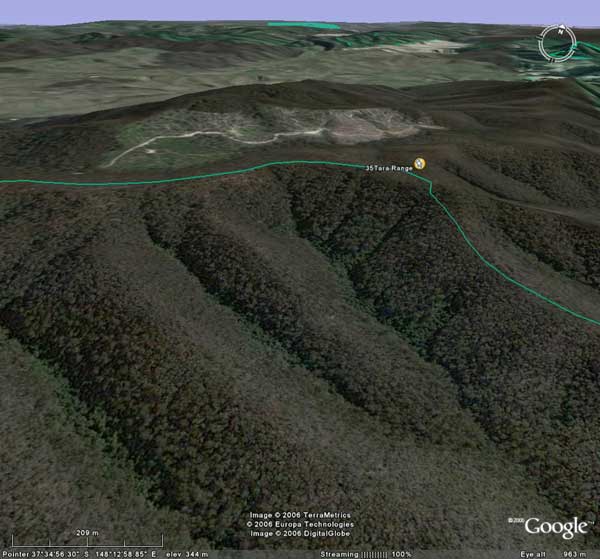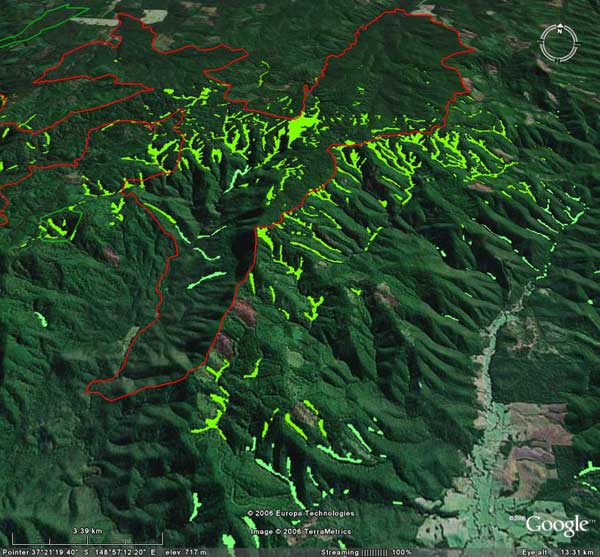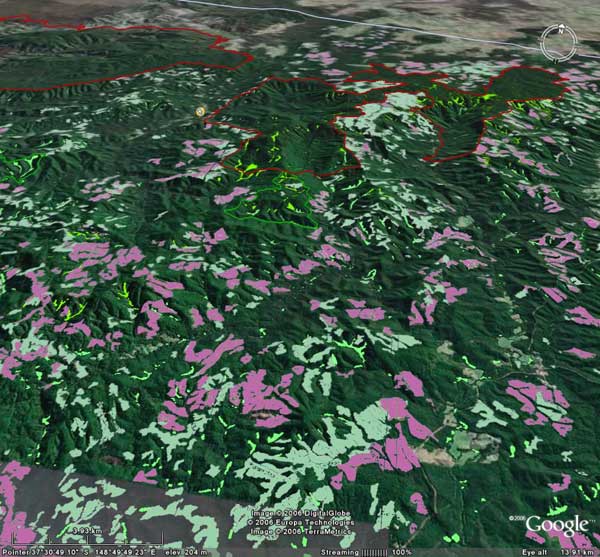Rainforest in Victoria.
When asked the question "what is rainforest?", many people think about lush tropical rainforests of northern Australia or in other countries such as the Amazon Jungle.
However it may come as a surprise to know that in Victoria there are three major distinct types of rainforest:
Rainforest in Victoria is rare, covering only 0.14% or 32,000 hectares of Victoria's total area. Although relatively small in overall size, these rainforests are the home to 30% of all Victoria's rare or threatened flora species.
Most of this rainforest is concentrated in just four regions: the Otways, the Central Highlands, South Gippsland and East Gippsland.
Click on a region to find out about rainforest in that location.

The darker green vegetation in the valleys are extensive stands of Warm Temperate Rainforest found on the Tarra Range which is North West of Orbost. This rainforest is within Rainforest Site of Significance 35. A clearfell logged area can be seen on the top of the ridge. (Image from Google Earth.)
Victorian rainforests of today have not only survived recent European land clearing, logging and wildfires, they have also survived great climatic changes on the Australian continent over hundreds of millions of years.
The small remnant rainforests in Victoria now grow predominantly in sheltered south facing gullies in fertile and high rainfall areas. The greatest threats to rainforest are wildfires and human activities (such as clearfell logging) that increase the probability that rainforest plant communities will be destroyed by wildfire if appropriate buffers are not put in place. Rainforest is an extremely important and irreplaceable part of the Victorian natural landscape.
Once lost, lost forever!

Download hi res PDF of this image
Errinundra in East Gippsland is a hotspot for rainforest, including the Errinundra National Park (red boundary line) and the Errinundra plateau. Cool Temperate Rainforest (shown as bright green![]() ) grows at a higher altitude while Warm Temperate Rainforest (light green
) grows at a higher altitude while Warm Temperate Rainforest (light green![]() ) grows at a lower elevation. Rainforest generally grows in sheltered south facing moist gullies where the rainforest plant communities are shaded from the sun and have a better chance of not being burnt by bushfires.
) grows at a lower elevation. Rainforest generally grows in sheltered south facing moist gullies where the rainforest plant communities are shaded from the sun and have a better chance of not being burnt by bushfires.

The cumulative affect of clearfell logging around rainforest in East Gippsland over the past 35 years. Pink areas ![]() were logged in the past 15 years and dull green
were logged in the past 15 years and dull green ![]() areas logged in the past 15 to 30 years. (Image from Google Earth.)
areas logged in the past 15 to 30 years. (Image from Google Earth.)
Copyright (c) by Victorian Rainforest Network.
This website and its contents, including pages and documents, are subject to copyright under the laws of Australia and, through international treaties, other countries. Unless otherwise indicated, the copyright to all original material on the site is owned by the Victorian Rainforest Network (VRN). Nonexclusive rights are granted to copy, duplicate, or print this material as long as this copyright notice is preserved and a link to http://www.vicrainforest.org/ is displayed.
Disclaimer
This website is operated by the Victorian Rainforest Network (VRN).
The information contained within this site has been compiled by the Victorian Rainforest Network (VRN) and is subject to change without notice. VRN has used its best endeavours to ensure that this information is correct and current at the time of publication but take no responsibility for any error, omission or defect therein.
To the extent permitted by law, the Victorian Rainforest Network (VRN) and its employees, agents, members and consultants exclude all liability for any loss or damage (including indirect, special or consequential loss or damage) arising from the use of, or reliance on, the information whether or not caused by any negligent act or omission. If any law prohibits the exclusion of such liability, VRN limits its liability to the extent permitted by law, to the re-supply of the information.
